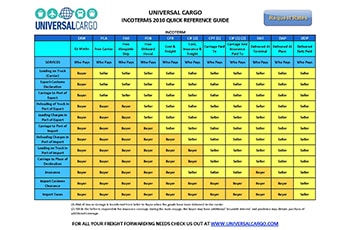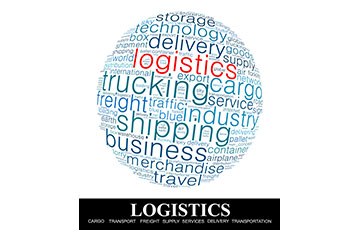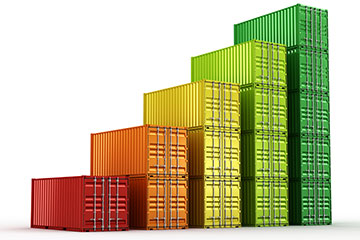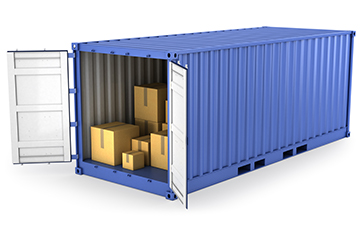Logistics Resources
Find Out How We Can Help You Today!
Frequently Asked Questions
“Freight forwarding is a service used by companies that deal in international or multi-national import and export. While the freight forwarder doesn’t actually move the freight itself, it acts as an intermediary between the client and various transportation services. Sending products from one international destination to another can involve a multitude of carriers, requirements and legalities. A freight forwarding service handles the considerable logistics of this task for the client, relieving what would otherwise be a formidable burden.
Freight forwarding services guarantee that products will get to the proper destination by an agreed upon date, and in good condition. The freight forwarding service utilizes established relationships with carriers of all kinds, from air freighters and trucking companies, to rail freighters and ocean liners. Freight forwarding services negotiate the best possible price to move the product along the most economical route by working out various bids and choosing the one that best balances speed, cost and reliability.
A freight forwarding service generally provides one or more estimates to the client along with advisement, when necessary. Considerations that effect price will range from origin and destination to special requirements, such as refrigeration or, for example, transport of potentially hazardous materials. Assuming the client accepts the forwarder’s bid, the freight is readied for shipping. The freight forwarding service then undertakes the responsibility of arranging the transport from point of origin to destination.
One of the many advantages of using freight forwarding is that it handles ancillary services that are a part of the international shipping business. Insurance and customs documentation and clearance are some examples. As a consolidator, a freight forwarding service might also provide Non-Vessel Operating Common Carrier (NVOCC) documentation, or bills of lading. Warehousing, risk assessment and management, and methods of international payment are also commonly provided to the client by the freight forwarding service.
A good freight forwarding service can save the client untold time and potential headaches while providing reliable transportation of products at competitive rates. A freight forwarding service is an asset to almost any company dealing in international transportation of goods, and is especially helpful when in-house resources are not versed in international shipping procedures.”
“While there are several factors involved, the primary is market demand. Traditionally from Dec through April for imports, especially from Asia to the U.S., it is called the “”slow season.”” Because the retail market slows down after Christmas. However from mid January through early February there is an upsurge of cargo moving to beat the Chinese New Year deadline whereby factories all over China shut down for weeks. This usually keeps rates high as there is always space problems for cargo getting on vessels. From May through November this would be the “”peak season”” where there is a big demand for cargo moving into the U.S., so the Carriers raise the rates during this period, with the GRI (general rate increase), and PSS (peak season surcharge).
Another factor is fuel, or what is called the Bunker Fuel factor. This is a floating surcharge that the Carrier’s can change when oil prices rise or fall. It is called the BAF.
Another factor is when the Carrier has increases in costs such as when Terminal costs rise, especially with Unions, congestion problems, etc. Or when the U.S Rail costs increase for similar reasons. This is where the Carriers can add in new surcharges which have happened in the past and eventually get absorbed into the “”all in “” rate quoted.
Most recently the primary reason for rate increases, was a knee jerk response to the tremendous downturn in traffic and volume as a result of the current U.S. recession since ’08. This downturn caused many carriers to lose about 50% of their previous volume and while their costs remained the same or higher, and their revenue all but disappeared, they found themselves the beginning of this year looking at an average of $500, 000,000 in losses per Carrier. So from late ’09 until May of ’10, most Carriers put a large portion of their fleet out of commission off the coast of Singapore. Thereby creating a vessel shortage, or a false space problem. This gave them all excuse to raise their rates again, in order to salvage their businesses. This type of thing is not normal.
See our Blog post about the dramatic rate increases during early 2010 (https://www.universalcargo.com/blog/bid/46390/Freight-Rates-and-Container-Shipping-Costs-up-350-from-China).”
Most freight payments are done with a Company check. However you can also pay with wire transfer or credit card (subject to administrative fee). Payment is sent right around the time the freight is due to arrive, clear customs and be released.
Yes. You would fill out a credit application that we would send you ahead of time, with all necessary banking information and references. Once your credit is approved, you would be granted the appropriate credit amount and length of time.
Firstly, make sure your supplier overseas (on imports) or if you are the supplier for an export shipment, creates all of the necessary documents correctly (packing lists, commercial invoice, original bill of lading-OB/L) and in a timely fashion, so that all documents are provided with the necessary banks and sent to you (the importer) or your buyer-consignee on the B/L (if you are the exporter) at least 1 week before cargo arrives the destination so that everything can be processed through customs ahead of schedule and freight can be paid along with presentation of the original B/L. One factor that usually slows this process down is when there is discrepencies between the buyer and supplier and since the goods are not paid for, the OB/L has not been surrendered by the Supplier to the Consignee (buyer)
This can be a touchy subject, as you may be a long time importer with a long time relationship with a particular supplier overseas, however a situation arises and for whatever reason you have not paid your supplier because they were supposed to give you credit, but there was a misunderstanding, they are not honoring the agreement, the next thing you know the cargo arrives and if you don’t get it released it goes into demurrage and or you may lose your customer because they have a deadline, and so on. So you desperately need that cargo released. So the ONLY way this can happen WITHOUT the OB/L is to somehow settle the matter with the supplier, get them to authorize the release in writing to the shipping agent in the port of origin, or direct to the U.S. Office that is holding the cargo. This can act in Lieu of an OB/L. This is no other legal way or one that doesn’t jeopardize the liability of the shipping company to be sued by the supplier if they release without their written consent.
Click Here to download a PDF document of our Terms and Conditions
About 7,500 a year
We have 5 tips for you.
Tip #1: Save container transport cost by preparing to load your container in less less than 2 hrs.
When the driver shows up to your site, the first 2 hours are included in your fees. We recommend staffing up and preparing in advance to load the container as quickly as possible to avoid overtime charges.
Tip #2: Prepare Shipping Container Contents for Extremes
Containers are subject to extreme conditions. There are wild swings in temperature and humidity inside the container – they go through the Panama Canal and sometimes around the Cape. Containers are subjected to triple digit heat and humidity to sub-zero temperatures while in storage or in transport.
Tip #3: Carefully Declare ANY Organic Cargo
Plants, Edible Plants, Vegetables and Fruit are all treated differently depending on the origin and destination of the shipment. If customs finds any undeclared organic cargo, the can quarantine your container and charge you daily holding fees.
Tip #4: Properly Insure Your Cargo
Plan for “attrition”. All of the contents don’t always make it all of the time.
There will be some “”attrition”” – containers get inspected, sometimes by unscrupulous dock/deck hands…this isn’t REALLY considered stealing, as the items in transit, technically are the property of the shipping company*. See our blog entry on securing, insuring and properly declaring your container contents to manage risk of inspection, suspicion, mistakes and “”attrition””.
Tip #5: Understand that Freight Forwarding is both an art and a science.
Many companies and handlers are involved in moving your container, here are just a few possible examples: Trucking company(ies) outbound (your door to the port of origin or train yard), Crane Operations transferring container from truck to train, and train to ship. That’s just to get the container to the ship, then the reverse happens on the other side…it’s a REALLY rough ride, even in good weather.
Yes, please follow this link https://www.cbp.gov/
Yes, please follow this link http://www.photius.com/seaports/.
Yes, air freight is based on both the actual weight and chargeable weight of the cargo.
There is a special formula.
Just give us all three dimensions and we will calculate the chargeable weight for you or you can download our conversion calculator here.
This varies depending on the airline so please ask us.
As a rule of thumb, maximum normal cargo dimensions: 120x80x60in.
As the weight and size increase so will the cost. If your cargo is oversized or requires special handling, ask us about special rates.
Yes, we have receiving warehouse near all major airports.
Please let us know your cargo location and we will advise you the closest receiving warehouse.
We will provide you with the necessary paperwork for custom clearance, once custom is done, you can go to the warehouse to pick up the cargo.
We also advise you to check with destination custom prior to shipment departs, just to make sure if there’s any special rule & regulation at destination for certain commodities
Yes, we have a lot of agents who we work with at different location.
Please check with us, they will be able to help you for any destination services.
Yes as long as this a commercial address. Please help to provide us your door address, and we will check the cost for you
There may be airport fees, warehouse fees, custom clearance charges, duty/tax and door delivery charges.
Of course, if your cargo is chosen for custom exam at destination, please prepare to home charges and delays for getting the cargo.
Ship only the most important items, pack in as small of a box, crate or pallet as possible.
If you can route from/to a major hub (JFK, LUH, BJS) instead of a smaller airport, this may help to lower your freight rate.
No, the airlines will reject any cargo that is not properly packed. Must be packed in a box, crate, or on a pallet. If there are any oversized items or cargo requiring special packing, please ask.
Airport to airport 3-5 days on average. Door to door varies depending on customs clearance, estimate 5-7 days.
Delays and/or changes to schedules can happen. Best way to make the cargo ship as quickly as possible is to make sure all paperwork is properly filed before hand, this eases the customs process.
Yes, anything hazardous, flammable, dangerous, chemicals, computer batteries, live animals, perishable items, etc.
We will send you some paperwork for you to fill out the basic information, Such as shipper and receiving party contact information.
Don’t worry, we will take care of all the export custom and paperwork for you.










